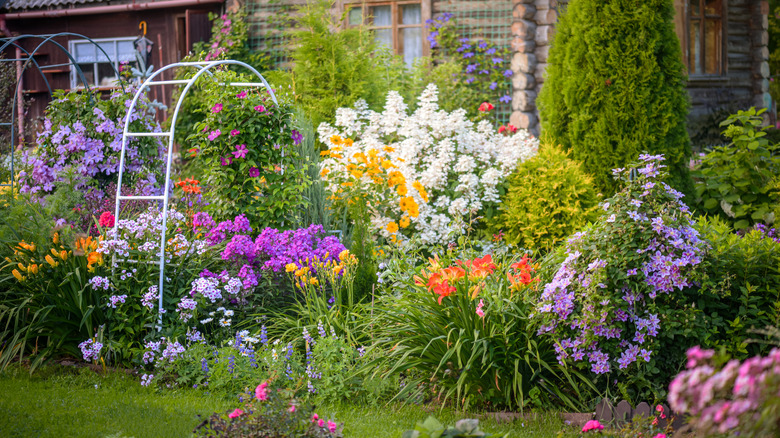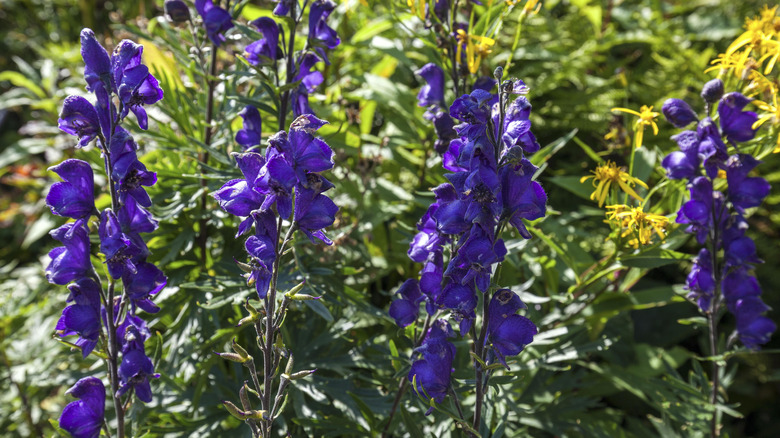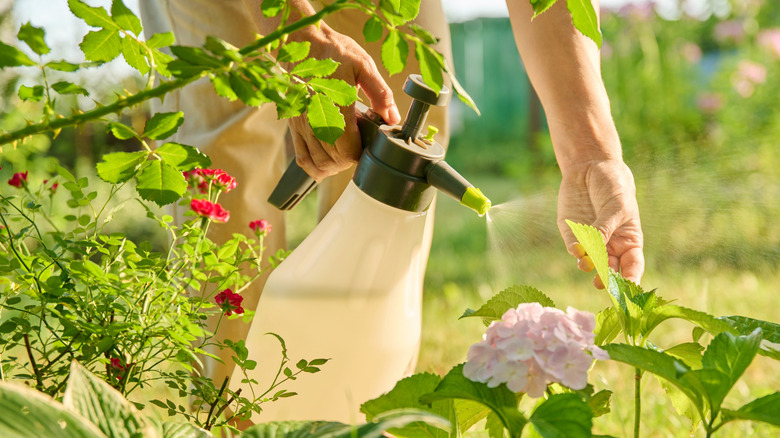The Dangerous Purple Flowers To Avoid Planting In Your Garden (And How To Safely Remove Them)
Nature has always taught us that beauty can sometimes be dangerous, so to assume that everything that grows from the earth is harmless is simply unwise. Monkshood flowers (Aconitum napellus) are a perfect example. They're a group of dense, vibrant purple flowers shaped like a bell or a hood with lobed dark green foliage. Despite the harmless appearance of these flowers, they're considered one of the most poisonous plants to grow in your garden. Monkshood is even known in some places as the queen of poisons. Ingesting any part of this plant can cause severe poisoning symptoms, sometimes within minutes after swallowing. Those symptoms include numbness, slow or fast heart rate, nausea, vomiting, abdominal pain, and diarrhea.
In severe cases, it can cause respiratory paralysis and heart rhythm abnormalities that can be fatal. To make matters worse, there is no immediate cure. You'll have to either try to treat the symptoms or wait it out. What's also scary is that accidentally brushing against or touching those plants can also subject you to these dangerous toxins. That's why you might not want to keep monkshood in your home garden, especially if you have children or pets. The good news is that you can completely remove the plant as long as you follow some straightforward safety precautions.
How to safely remove monkshood from your garden
When dealing with monkshood, the first thing to be aware of is that aconitine, the main toxin in the plants, can be easily absorbed through the skin. When that happens, it can cause heart irregularities. This means that whenever you're in a position where you have to touch these plants, you should wear gloves and full protective gear. If you don't have protective gear, however, you can try to wear long sleeves, pants, and boots to ensure that your skin isn't in direct contact with the plant. As long as no parts of your skin are exposed, you can safely begin the removal process.
To remove this plant and make sure it won't regrow, you should focus your attention on removing its root system entirely. Not only are roots the most toxic part of the plant, but, like most perennials, they're also what makes the plant regrow again every spring. To ensure the full removal of the plant from its roots, you should dig around the base using a fork or a spade to loosen the soil. Once you do that, carefully remove the plant and place it in a heavy-duty plastic bag labeled as hazardous waste and dispose of it following the regulations in your area. When you're done, thoroughly clean and disinfect your clothes and tools to prevent any accidental contact with the plant's toxins later on.
Tips for preventing the regrowth of monkshood
To prevent the regrowth of monkshood, you'll want to completely dispose of all parts of the plant without adding them to any compost piles. You'd also benefit from removing the plant when it's most dormant during winter and fall. If monkshood is located in areas that are hard to reach, you can try to use a suitable amount of herbicides (like glyphosate) directly on the stem of the plant to get rid of it. Be aware that glyphosate is a non-selective herbicide that can seep into the soil and hurt other plants, so avoid spraying it on the ground or near other beneficial plants.
Be sure to monitor the area and reapply herbicides when regrowth appears. As when you're dealing with other unwanted plants and bushes that keep growing back in your garden, planting easy-to-grow ground covers or beneficial alternatives will help you keep a healthy garden and direct the source of nutrients toward your desired plants.


